|






| |
John has used a Nikon Coolpix 995 point-and-shoot as well as a Pentax ist DS dSLR
for astrophotography, but now uses a modified Canon T1i (500D) dSLR equipped with a variety of lenses. Processing software includes ImagesPlus,
Photoshop and Neat Image. He uses a William Optics 105mm apochromatic refractor
or a 10" Newtonion, both mounted on an HEQ5 for both visual and
photography. John
McDonald's Personal Astronomy Website
For current images, please refer to
John's Zenfolio Online Gallery (see above slideshow)
Please note: the page below contains an
archive of John's images dated from mid-2007. John's Gallery covering 1997-2006
| Costa Rica Southern Sky Fiesta - February 2008
Attending the 2008 Southern Sky Fiesta tour with my wife Wendy was a truly
memorable event for both of us. Wendy was mostly a day person and went
hiking and horseback riding. I did some daytime activities (boat tour of a
mangrove swamp, hike in the rain forest and a tractor ride over the Ensenada
farm). However, I spent most nights out till dawn and was thrilled with the
views of the southern sky. I saw the LMC, Crux, the Coal Sack, Omega
Centauri and much more for the first time and it was great. Gary Seronik led
the tour and provided excellent talks and binocular sky tours. Wendy tells
me we are going again next year and who am I to argue?
Below, please find two time-lapse movies of
the southern sky at night as well as our images of day activities and the
night sky as found at La Ensenada, located 10 degrees north of the equator
on the Gulf of Nicoya in Costa Rica.
John &
Wendy's Costa Rica 2008
|
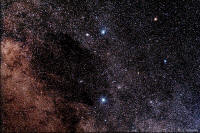
Crux and Coalsack |
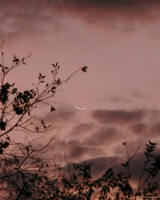
Crescent Moon |
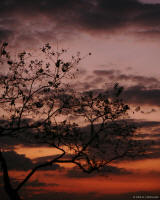
Crescent Moon |
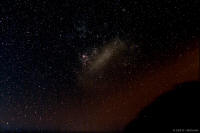
Large Magellenic Cloud |
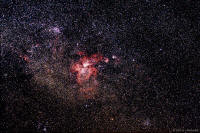
Eta Carinae |
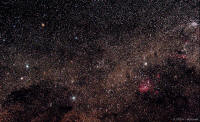
Crux-Eta Carinae region |
The Moon and Jupiter from near Canmore, Alberta - June
2007
Here are some images taken from the deck of our condo in Canmore. One is of
the moon over one of the Three Sisters and looks like the moon is trying to
find a landing spot. The other shows Jupiter over the same mountains in the
evening light. If you blow it up three of the moons are evident. They are
from left to right Callisto, Europa and Granymede.
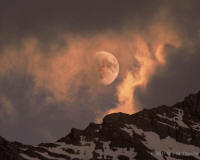 |
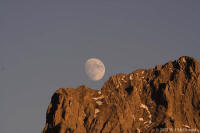
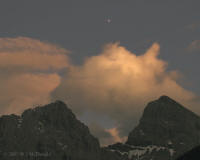
|
M101 - June 11, 2007
Last night after I lost the NGC objects in the clouds and trees, I could see
that M101 was still out of the clouds. Transmission was poor and the
location was in the direction of city light pollution so the results are not
great. Still, I had never imaged this one before so I am pleased to have
something. I am looking forward to trying this one again when I have a
really dark sky.
Date and location- morning of June 11, 2007 - backyard in Fairfield.
Equipment- Williams 105mm with modified Canon 350D on HEQ5 mount.
Exposures- used 50 of 51 lights and 25 darks all 58s at ISO 800. 25 flats
were also used in the calibration.
Processing- Stacking and digital development in ImagesPlus with additional
processing in Photoshop. |
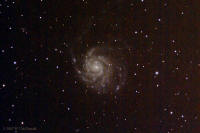 |
| NGC5466 & NGC5053 - June 10, 2007 Last night was
very mixed for sky conditions with some clear periods with some wind and
increasing cloud and lowered transmission in the am. At the suggestion of
Jim Nemec I had a go trying to capture NGC 5053 and 5466. Bill Weir had
warned me that these objects need a good dark sky and and noted that 5053 is
really difficult so I was not expecting great results from my backyard.
Still, I like the challenge of seeing what I can image from my urban
location and it is possible to see both of them in the images (barely in the
case of 5053). I could not really be sure
5053 was in the frames while I was shooting but I positioned M53 at the edge
hoping that would put 5053 in the frame. It worked although the framing is
not the greatest. You should be able to see 5053 on the left side and M53 is
clearly shown at the upper right.
Details:
NGC 5466
Date and location- June 10/11, 2007 in backyard, Fairfield, Victoria.
Equipment- William Optics 105mm with modified Canon 350D on HEQ5 mount.
Exposures- used 52 of 60 lights and 25 darks all 58s at ISO 800. 25 flats
were also used in the calibration.
Processing- Stacking and digital development in ImagesPlus with additional
processing in Photoshop.
NGC 5053 and M53
Date and location- June 11, 2007 in backyard, Fairfield, Victoria.
Equipment- Williams 105mm with modified Canon 350D on HEQ5 mount.
Exposures- used 11 of 13 lights and 25 darks all 58s at ISO 800. 25 flats
were also used in the calibration.
Processing- Stacking and digital development in ImagesPlus with additional
processing in Photoshop. |
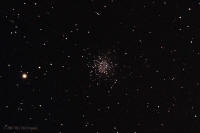
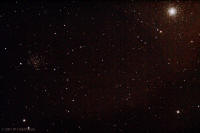 |
| M16 Eagle Nebula - June 8, 2007 Finally, I got a
really clear sky that I was waiting for overnight on Thursday. It was cloudy
early in the evening but cleared as the night progressed and turned into the
best night I have had this year for imaging. The temperature was 12 degrees,
transmission and seeing very good and no wind. I had been wanting to try my
modified Canon 350D on a target with lots of H-alpha nebulosity and the
Eagle Nebula seemed like a good bet. It was up high enough to be above the
trees and in clear air by midnight and the moon did not rise until after
1:30am. I am quite pleased with the result and especially the amount of
nebulosity that shows up in and around the core of this nebula. I think the
image is a keeper.
Details:-
Date and location - June 8 between 12:04 and 1:32am in my backyard in
Fairfield, Victoria.
Equipment - Williams Optics 105mm refractor and Canon 350D camera on
Skywatcher HEQ5 mount.
Exposures - Used 57 of 62 light frames each 58s at ISO 800 plus 25 dark and
25 flat frames.
Processing - Stacked in ImagesPlus, stretched and enhanced using Photoshop
and Astronomy tools. |
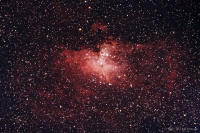 |
| M13 Hercules Cluster & M92 - June 7/8, 2007 While
I was waiting for the Eagle Nebula to get high enough on Thursday night I
spent some time on clusters to get good focus. I ended up taking some frames
of M13 and M92 and the attached shows what resulted. The one of the Hercules
Cluster (M13) goes deeper than I had managed before and as a result it shows
more stars. M92 is dimmer and smaller and had less exposure but still came
out fairly well.
Details:
Date and location - June 7/8 in my backyard in Fairfield, Victoria.
Equipment - Williams Optics 105mm and Canon 350D camera on HEQ5 mount.
Exposures - M13-Used 24 of 29 light frames each 58s at ISO 800 plus 25 dark
and 25 flat frames.
Exposures - M92- 13 light frames each 58s at ISO 800 plus 25 dark and 25
flat frames.
Processing - Stacked and digitally developed in ImagesPlus. Additional
enhancement in Photoshop. |
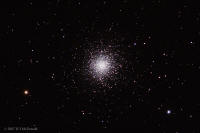
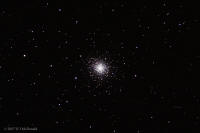 |
| M27 Dumbell Nebula - 2006 & May 24, 2007 I have
been putting together the results of three sessions on M27 and the attached
is the result. Two of the sessions were from last July at Observatory Hill
using a Pentax on the Williams Optics 105mm and the third was last Thursday
at Cattle point using a modified Canon 350D. I only managed to get 17 light
frames of 58s each with the Canon and the transparency was bad but even so,
I got quite a bit of color, especially some nice reds from H alpha light.
The Pentax sessions had a total of 138 30s light frames and gave a more
detail as a result of the longer exposure.
Processing details:
Aligned the results of the 3 sessions using ImagesPlus. Because the 2006
sessions were done with a focal reducer and Thursdays session was done
without it I aligned using the "translate/rotate AND SCALE" command.
Amazingly, the images came into excellent alignment despite the different
optics and cameras used. The aligned images were blended together in
Photoshop. The Canon image was used as the base or background and I used a
"color screen blend" for one of the Pentax session images and a "lighten
blend" for the other |
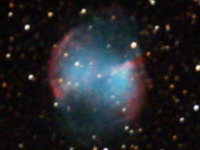 |
| M5 & M10 Globular Clusters - May 22, 2007 In the
bits of clear air I had a go at M5 and M10 last night from my back yard. I
am fascinated with globular clusters because of their age and the puzzle of
how they formed and have lasted so long. I am pretty happy with the image of
M5. M10 could use more exposure but I ran out of clear sky.
Details:
Location and date- Backyard in Fairfield, Victoria May 22/23
Equipment- WO 105mm with Canon 350D camera
Exposures-
M5 - 50 light, 25 dark and 25 flat frames
M10- 14 light, 25 dark and 25 flat frames
Processing- ImagesPlus and Photoshop |
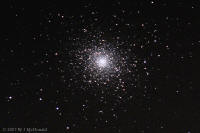
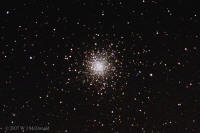 |
| M104, Sombrero Galaxy - May 17, 2007 After
capturing comet Lovejoy last evening, M104 was well situated for imaging and
the skies got fairly clear as well. There was still quite a bit of sky glow
so I decided to use ISO 400 with 58 sec exposures. I am attaching a full
frame wide field image and the cropped version.
Details:
Location and date - Backyard in Fairfield, May 17/18, 2007 Equipment - WO
105mm with modified Canon 350D and 0.8x focal reducer Exposure - 61 58s
lights, 25 Darks and 25 Flats at ISO 400 Processing - ImagesPlus and
Photoshop |
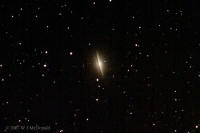
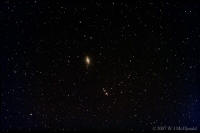 |
Comet Lovejoy C/2007 E2 and NGC 6015 - May 17, 2007
After sending out my first attempt at Comet Lovejoy, I thought it might be
fun to measure the angular velocity of the comet from its track on my image.
I also had several more light frames from initial shots when I was adjusting
the scope to get the frame set. Since, I could not really see the comet, I
had spent some time checking my pointing as best I could. It turned out that
all of my frames had the comet in them and I was able to use them all to get
a bit longer track and less noise. I also took some more dark frames to
reduce noise from that source and put more care into the processing. The
result is less noisy and the track is longer (see attached). The exposures
covered the period from 10:57PM to 12:03AM PDT and the track measures 2.80
arcmin (+/- 10%). so the comet was moving at a rate of 2.55 arcmin/hr (+/-
10%).
Details:
Location and date - Backyard in Fairfield, May 17, 2007 Time of exposures -
from 10:57PM to 12:03AM PDT Equipment - WO 105mm with modified Canon 350D
and 0.8x focal reducer Exposure - 43 - 58s lights, 25 Darks and 25 Flats at
ISO 800 Processing - ImagesPlus and Photoshop |
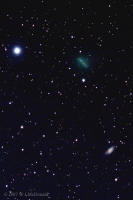
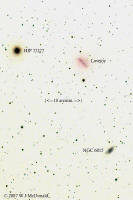 |
| Moon-Venus Conjunction - May 19, 2007
Jim Cliffe got a lovely image of the conjunction earlier this evening.
The view from the parking lot at the CU was also nice tonight at 10:20PM
when I took this image. Clouds everywhere except for the Moon and Venus.
Pretty lucky!
Details-
Tripod mounted Canon 30D with 300mm F4L lens Exposure f/7.1, for 1/20 sec.
at ISO 100.
Processing in Photoshop included a slight enhancement of local contrast and
mild sharpening. |
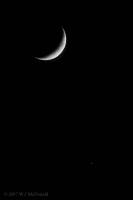 |
| Comet Lovejoy C/2007 E2 and NGC 6015 - May 17, 2007
The comet was so dim in the raw frames that I thought it would not be
possible to align on the comet itself so the previous processing just used
star alignments. That resulted in the comet image being a track of the
comets path rather than a sharp image of the comet itself.
Last night I thought of a way to align on the comet and the attached is the
result. I think I can see a bit of the tail stretching off to the right now
but you can judge this for yourselves.
For those that want to know how it was done here are the details:
1) Convert and calibrate Raw images as usual.
2) Stretch using digital development the individual frames from step 1).
Normally digital development is used after aligning and stacking but the
comet could not be seen well enough to align it without stretching first.
3) Align using translate and rotate on stars first. I needed this step as
there was some rotation during the period when I was centering the target.
4) Align again but this time on the comet.
5) Combine aligned frames as usual.
6) Finish with some additional smoothing and enhancing in Photoshop. |
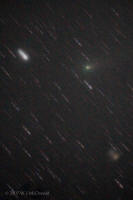 |
| NGC 7000, North America Nebula - May 9/10, 2007 I
have been trying to refine my image processing and the North American Nebula
is my deepest image to date so I am using it to try things on. The attached
image show the best I have done so far As you will see, I have been able to
tease out quite a bit more detail compared with my previous image (see
below).
For anyone interested in the details, the main differences in processing are
described below.
This image is the latest and was processed using some ideas from Ron
Wodanski. Instead of using Digital Development in ImagesPlus, it uses a
series of stretches using the "curves) routine in Photoshop. Wodaski's
technique is not as easy or automatic as Digital Development but it does
seem to offer more control. I also used the "local Enhancement" routine from
Astronomy Tools to provide some fine tuning to the contrast.
The image below used the same processing techniques that I have been using
for recent images - ImagesPlus Digital Development routine to enhance the
image and Photoshop to bring out the nebulosity.
Finally, A bit of smoothing of the darker parts and sharpening of the
brighter ones has been applied to all of all the images using Photoshop.
I like the latest one best. The extra detail in the nebulosity is nice to
see and the reds are not quite so overwhelming. |
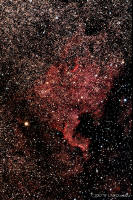 |
| NGC 7000, North America Nebula - May 9/10, 2007
Last night after the RASC meeting, Charles suggested we go to Cattle Point
and stay late as it looked like a good night. As the night progressed some
of the objects that are rich in H-alpha came up giving me a chance to try my
recently acquired 350D camera. This is one with a modified filter to pass
H-alpha light. I tried the North American Nebula and got the attached
result. The modified camera appears to be quite sensitive overall and
especially good in the red as expected. Next, I want to try it with my 105mm
refractor.
By the way, it was a long night as I did not get to bed until 3:30am. How
does it go again "..........light years to go before I sleep..."
Details-
Location and date: Cattle point 2007-05-09/10
Camera: Canon 350D modified with Baader UV/IR filters by Hap Griffin
Lens: Canon 80-200 f2.8L operating at 200mm fl and f3.5
Mount: Skywatcher HEQ5
Exposure: 69-58sec light frames at ISO 800
Calibration: 23 Dark and 25 Flat frames
Processing: Stacking and digital development in Images Plus with some
additional processing in Photoshop |
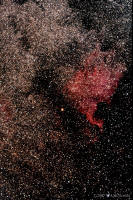
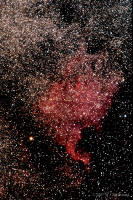 |
| M64, the Black Eye Galaxy - April 14, 2007 M51,
the Whirlpool Galaxy - April 15, 2007
Here are some more images from Saturday night in my backyard. While
Charles was shooting his wonderful ultra deep field of the Coma region, I
focused on two galaxies, M51, the Whirlpool and M64, the Black Eye. I did
M64 first and planned to stop as the clouds kept obscuring the target but it
got better after midnight so I had a go with M51 until 2:30AM. I'm glad I
did as there have been few nights as good recently.
Details:
Location and date - Backyard in Fairfield, Victoria April 14/15 Equipment -
WO 105mm refractor, Canon 30D Camera and 0.8x focal reducer Exposure - 47
and 54 light frames were taken for M51 and M64 respectively, each 58s at ISO
800. 25 dark, 15 flat and 15 bias frames were used for calibration.
Processing - ImagesPlus and Photoshop |
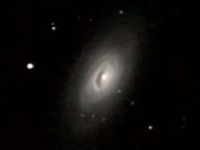
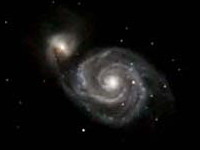 |
| Venus and M45 Pleiades - April 14, 2007 Charles
and I met in my backyard last night to do some imaging and Joe dropped in as
well. It was a strange night with some good clear periods followed by fast
and slow moving clouds nearly totally obscuring the sky at times. I tried
imaging Venus and Pleiades first and the attached are some of the results.
Details
Image 1- (1642) - Tripod mounted Canon 30D with 17-50 mm Tamron f2.8 lens at
50mm fl Exposure f3.2, 2s at ISO 200
Image 2- (1664) Tripod mounted Canon 30D with Canon 80-200 mm L lens at
155mm fl Exposure f2.8, 1s at ISO 800 Both images processed in Photoshop |
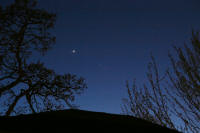
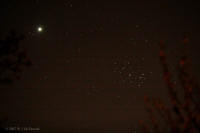 |
| Saturn - April 11, 2007 It is tough to find a hole
these days but I managed to get some clear air for a while last night. It
was quite moist but the seeing was not bad and I got my personal best image
of Saturn before it socked in at 2AM. I like the color which is just as it
came out of the camera.
Details
Telescope:- Skywatcher 8" Newtonian on HEQ5 mount
Camera:- Nikon Coolpix 995 coupled afocally to a 6.4 mm eyepiece Camera
settings:- VGA(640x480px) continuous drive mode and max. zoom
Exposures:- Used the best 24 of 73 1/4s exposures at ISO 200
Processing:- Aligned, graded, stacked, stretched and sharpened (using the
Richard Lucy algorithm), all in ImagesPlus |
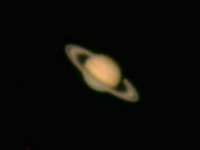 |
| Leo Triplet of galaxies M65, M66 and NGC 3628 - Mar 21,
2007 Last evening the usual clouds were missing and I took the
opportunity to do some imaging from my backyard. The transparency was not
great and there was some wind at times but it was better than most of the
recent nights.
Details-
Location: Backyard in Fairfield, Victoria, BC
Date and time March 20/21 2007 between 11:59PM and 12:56AM.
Equipment: Williams 105mm scope and 0.8x focal reducer with Canon 30D on
Skywatcher HEQ5 mount.
Exposures: 50 light frames and 25 dark at ISO 800 for 58s each with an
additional 10 Bias and 10 Flat frames for calibration.
Processing: ImagesPlus and Photoshop. |
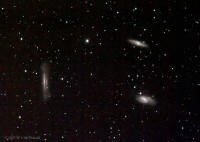 |
| M81, M82, NCG3077 - Jan 11, 2007 It was pretty
crazy to go up on the hill on such a cold night but on Jan. 11 Charles and I
had to do it as we were suffering from clear sky deprivation. The sky was
not as dark from the lower parking lot as we would have liked and the
transparency was not wonderful but it was the best night we had seen for
some time. Temperature was -4deg C with a nasty wind chill. As you will have
seen, Charles Banville got stunning
images of the Pleiades and M42. I concentrated on testing my new Canon
Camera on M81/82 and the attached images are the result.
Details
Equipment: Williams 105mm with 0.8x focal reducer and Canon 30D camera on
HEQ5 mount.
Exposures: 78 60 sec. light, 17 Dark and 10 flat frames.
Processing: ImagesPlus and Photoshop |
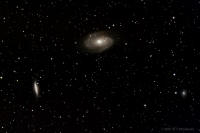
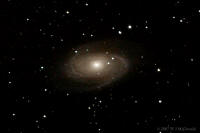
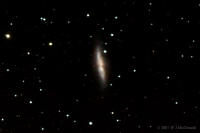 |
| Comet
McNaught C2006 P1 - Jan 11, 2007 Wow, it is a beautiful comet. I went
to Moss Rock at sundown today and got several images of the comet. Here is a
sample. |
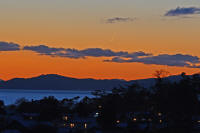 |
John's Gallery covering 1997-2006
|